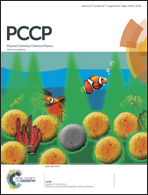DFT calculations on kinetic data for some [4+2] reactions in solution†
Abstract
The reaction mechanisms of [4+2] cycloaddition reactions between dienes and dienophiles have been investigated with several density functional theory (DFT) methods, such as CAM-B3LYP, BMK, M062x wB97x and wB97xd, and the obtained results show that most of the reactions are synchronous or asynchronous. The stability of the transition state is moderated by the interaction of frontier molecular orbitals (FMOs), in which a diene acts as an electron-donating partner and a dienophile acts as an electron-acceptor from the charge transfer direction in the transition state. The activation free energy barriers have been calculated with both gas-phase translational entropy and solution translational entropy, in which those from gas-phase translational entropy (output of the Gaussian job) are far away from the experimental estimations. It has been found that free-energy barriers generated from solution translational entropies with CAM-B3LYP+IDSCRF/6-31G(d), BMK+IDSCRF/6-31G(d) and wB97x+IDSCRF/6-31G(d) are very close to the experimental measurements, but both M062x and wB97xd methods predict too low free-energy barriers for most of the studied reactions. The substituent and solvent effects on reaction dynamic data have also been addressed.
![Graphical abstract: DFT calculations on kinetic data for some [4+2] reactions in solution](/en/Image/Get?imageInfo.ImageType=GA&imageInfo.ImageIdentifier.ManuscriptID=C4CP02068E&imageInfo.ImageIdentifier.Year=2014)

 Please wait while we load your content...
Please wait while we load your content...